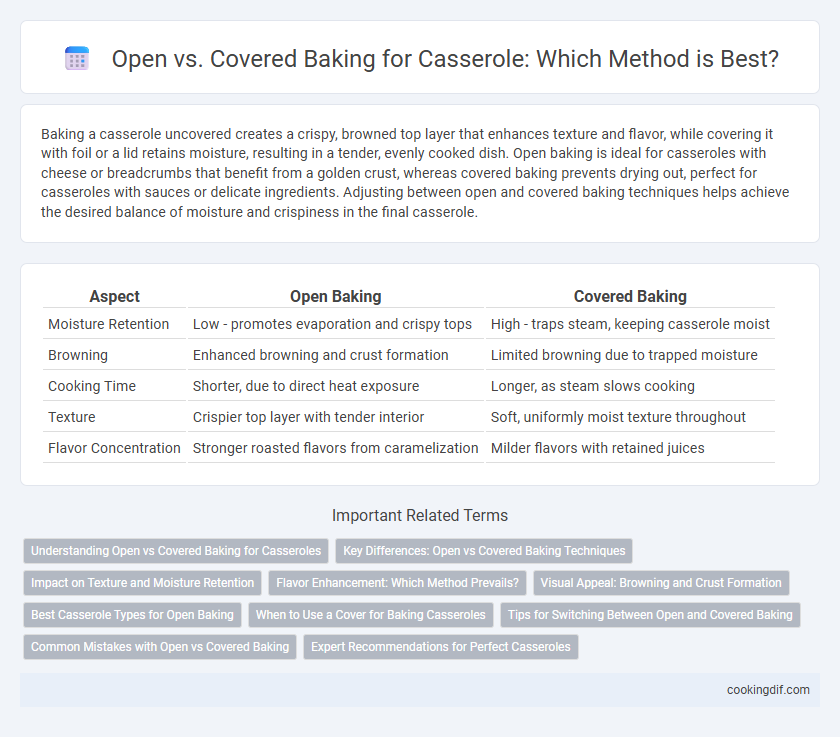Baking a casserole uncovered creates a crispy, browned top layer that enhances texture and flavor, while covering it with foil or a lid retains moisture, resulting in a tender, evenly cooked dish. Open baking is ideal for casseroles with cheese or breadcrumbs that benefit from a golden crust, whereas covered baking prevents drying out, perfect for casseroles with sauces or delicate ingredients. Adjusting between open and covered baking techniques helps achieve the desired balance of moisture and crispiness in the final casserole.
Table of Comparison
| Aspect | Open Baking | Covered Baking |
|---|---|---|
| Moisture Retention | Low - promotes evaporation and crispy tops | High - traps steam, keeping casserole moist |
| Browning | Enhanced browning and crust formation | Limited browning due to trapped moisture |
| Cooking Time | Shorter, due to direct heat exposure | Longer, as steam slows cooking |
| Texture | Crispier top layer with tender interior | Soft, uniformly moist texture throughout |
| Flavor Concentration | Stronger roasted flavors from caramelization | Milder flavors with retained juices |
Understanding Open vs Covered Baking for Casseroles
Open baking allows casseroles to develop a golden, crispy top layer by promoting moisture evaporation and browning, ideal for dishes with cheese or breadcrumb toppings. Covered baking traps steam, maintaining moisture and tenderness inside the casserole, perfect for recipes with delicate ingredients or that require slow cooking. Choosing between open or covered baking depends on the desired texture and moisture level of the final casserole.
Key Differences: Open vs Covered Baking Techniques
Open baking for casseroles allows moisture to evaporate, resulting in a crispy, browned top and a thicker texture, while covered baking traps steam, keeping the ingredients moist and tender with softer consistency. Covered casseroles require less frequent checking and are ideal for dishes needing prolonged cooking times to develop flavors without drying out. Open baking is preferred for toppings like breadcrumbs or cheese that benefit from direct heat to create a golden crust.
Impact on Texture and Moisture Retention
Baking casseroles covered traps steam, enhancing moisture retention and producing a tender, juicy texture. Open baking allows moisture to evaporate, resulting in a crispier, browned top layer with a firmer consistency. Selecting between open or covered baking directly influences the casserole's final texture and moisture balance.
Flavor Enhancement: Which Method Prevails?
Open baking allows moisture to evaporate, concentrating flavors and creating a crispy, caramelized top that enhances the casserole's taste profile. Covered baking traps steam, preserving moisture and resulting in a tender, evenly cooked dish but with a milder flavor intensity. For maximum flavor enhancement and texture contrast, open baking typically prevails.
Visual Appeal: Browning and Crust Formation
Open baking enhances the visual appeal of casseroles by promoting browning and crisp crust formation through direct exposure to oven heat. The Maillard reaction intensifies flavor and creates an attractive golden-brown surface, while covered baking traps steam, resulting in a softer, less browned top. Choosing between open and covered baking depends on the desired texture and presentation, with uncovered casseroles standing out for their appealing crust and coloration.
Best Casserole Types for Open Baking
Open baking casseroles like au gratins and baked pasta dishes benefit from direct heat exposure, promoting a crisp, golden-brown crust. Types such as lasagna, macaroni and cheese, and scalloped potatoes excel in uncovered baking, allowing moisture to evaporate and flavors to concentrate. Ceramic and glass casserole dishes are ideal for open baking due to their even heat distribution and ability to withstand high oven temperatures.
When to Use a Cover for Baking Casseroles
Using a cover for baking casseroles helps retain moisture and ensures even cooking, especially for dishes with ingredients that dry out easily, like poultry or pasta. Covered casseroles benefit from slow, consistent heat that prevents browning too quickly and keeps sauces from evaporating. Uncovered baking is ideal when a crispy top or caramelized texture is desired, such as with cheese toppings or breadcrumb crusts.
Tips for Switching Between Open and Covered Baking
Switching between open and covered baking for casseroles requires adjusting cooking times and monitoring moisture levels closely. Covered baking traps steam, which keeps the casserole moist and reduces browning, while open baking allows for a crispier, golden top by letting moisture evaporate. To achieve the best texture, start covered to cook fillings thoroughly, then uncover during the last 10-15 minutes to brown and crisp the surface.
Common Mistakes with Open vs Covered Baking
Common mistakes with open vs covered baking for casseroles include underestimating moisture retention and uneven cooking. Baking uncovered often leads to a dry casserole surface, while covering traps steam that can cause sogginess. To avoid these issues, adjust cooking times and monitor internal temperatures closely for optimal texture and flavor.
Expert Recommendations for Perfect Casseroles
Expert recommendations for perfect casseroles emphasize using an open baking method to achieve a crispy, golden top layer, especially for dishes with breadcrumbs or cheese toppings. Covered baking is preferred for retaining moisture and ensuring even heat distribution in casseroles with delicate ingredients like seafood or vegetables. Adjust baking times and oven temperatures based on coverage to prevent sogginess or overcooking, optimizing texture and flavor.
Open vs covered baking for casserole Infographic

 cookingdif.com
cookingdif.com